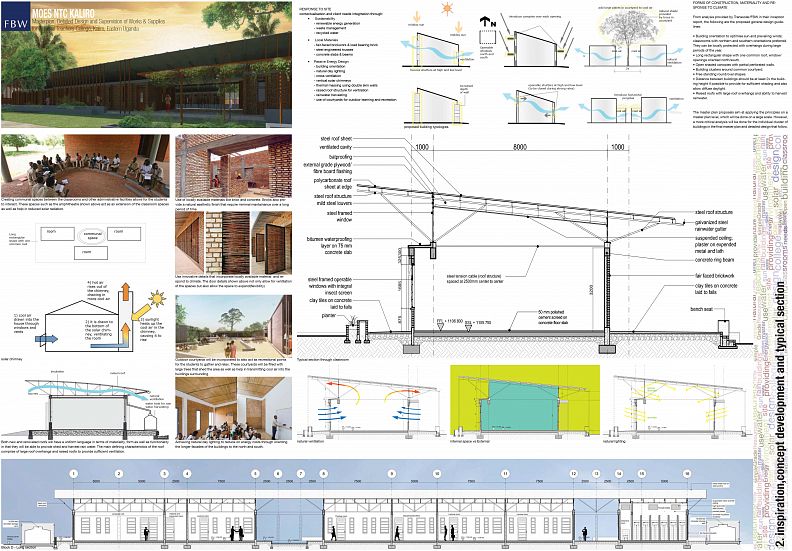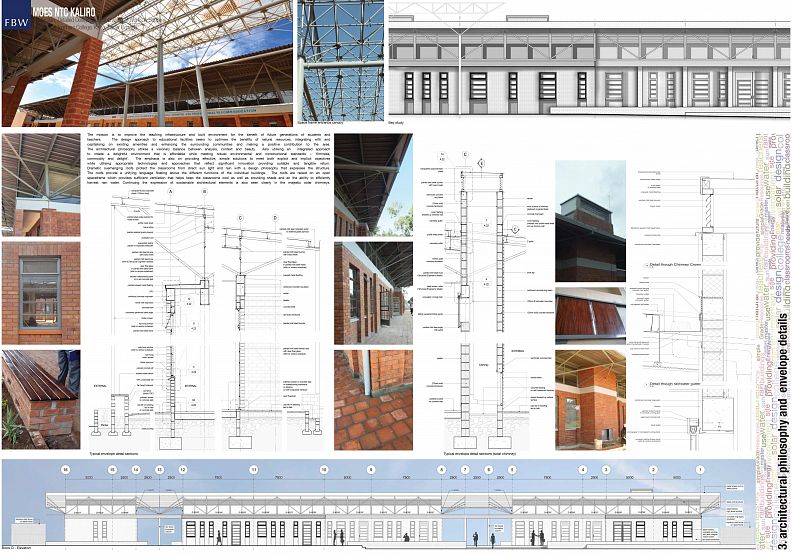MOES NTC KALIRO: Masterplan, Detailed Design and Supervision of Works & Supplies for National Teachers College, Kaliro, Uganda

Project idea
Introduction:
FBW was appointed by the Ministry of education and sports (MOES) and the Belgian Development Agency (BTC) to develop master plans, detailed design and supervision of works and supply of furniture for the National Teacher’s College (NTC), Kaliro. The construction and rehabilitation of the National Teachers College (NTC), Kaliro forms part of the Government of Uganda’s “Teacher Training Education – TTE Project”
The project was aimed at improving the teacher training provided at NTC Kaliro. This was to be achieved by expanding and rehabilitating the existing college as a strategy to promote skills training for development and eradication of poverty. The master plan developed provides for the phased growth (see three phases below ) of the college campus over the next 20 years. The 198 acre site has capacity to grow to provide approximately 14,125 m2 of new teaching, research, administration and residential buildings.
Phase 1 :Administration and education center
Phase 2: Staff accommodation and demonstration school
Phase 3: Student housing
Phase I (the focus of this presentation) offers new learning and community areas at the heart of the development. It is an appropriate statement of intent for the quality and vision of future development in the NTC Kaliro Campus. Its size and location have given an opportunity to develop a clear identity for the college that have grown out of the climate and context - and where possible will transform those particular conditions to serve the academic vision of the college. The proposed plans consider the site, climate, access, relation to the community, education, physical aspects, sustainability and vision of the college and proposes a specific phasing strategy to achieve the goals set out by the master plan.
Project Location
National Teachers’ College, Kaliro is situated in an isolated and relatively deprived rural area in Eastern Uganda. The college is located in Kaliro district which is approximately 150km from the capital city Kampala and college is about 3.5km from the civic centre( Kaliro town).
Site Analysis:
Climate in Kaliro is relatively moderate with prevailing winds which appear to be on a north/south axis with a high amount of solar radiation. The college started as a Grade II Teachers’ College in the 1970s upgrading to Grade III in the 1980s and eventually to its present status of a Grade V Teachers College since 1985.
Present Land use:
• Approximately 40% used space (inclusive of compounds), 60% is vacant land.
• Land is relatively flat with natural drainage patterns.
• Buildings were constructed in the 1970’s while some structures were incomplete and have dilapidated over time.
• Only the main administrative building appears to have been maintained over the years
Site Challenges
• There was presence of laterite soil which took the Contractor time to break through during construction of foundations.
• The land the college occupied had no security perimeter fencing exposing it to encroachers.
• All drainage and drain systems within the college were gravitational. This was not adequate as areas with no gradient easily got soggy and clogged.
Project goals and objectives:
At the beginning NTC Kaliro identified the following goals in their action plan:
• Upgrade master plan to account for infrastructure improvements and appropriate building orientation.
• Ensure decisions take into account needs of the college, in the immediate, mid, and long term scenarios.
• Quality management and sustainability requirements including cost-effectiveness, minimization of maintenance needs through the use of durable materials and simple shapes.
• User friendly design that includes users’ comfort, respect of gender and environmental issues.
• Flexible furniture layouts to accommodate variable teaching methods as well as present and future growth needs of the college.
• Aesthetics of the facilities providing a studious and stimulating environment; the construction should be functional, simple but at the same time aesthetically attractive.
• Protection of the environment through reduction or omission of the use of materials that contribute to the depletion of scarce resources, providing sound solid waste and waste water disposal/treatment provisions, and prevention of valuable vegetation.
• Security of facilities from public intrusion.
Project description
Brief
The brief was to design a responsive and sustainable master plan and buildings that addressed space, function, energy needs of the college and above all ensuring comfort to the students as to facilitate the learning process.
The master plan optimizes site constraints and opportunities whilst delivering the colleges vision and responding positively to the requirements of the community.
Completed early 2017, Phase 1 provided a total new build of 1690m2 consisting of a 2 libraries, 2 IT Laboratories, 7 lecture rooms, 1 language lab and staff offices:
Block C1 (390 m2):
• Library for 200 volumes of books and study area
• IT room for 40 computers
Block C2 (190m2):
• 2 student lecture rooms
Block C3 (215m2)
• Library 168 volumes of books and study area
Block C4 (170 m2)
• IT room for 80 computers
Block D (446 m2)
• 3 lecture rooms
• 1 language lab
• 1 departmental office
Block E (280 m2)
• 4 lecture rooms
Duration: June 2013 - February 2017
Project Budget: $ 3,000,000
Design Principles/Philosophy
MOES (Ministry of Education and Sports) and BTC’s (Belgian Development Agency) mission was to improve the teaching infrastructure and built environment for the benefit of future generations of students and teachers.
FBW’s design approach to the phase 1 seeked to optimize the benefits of natural resources, integrating with and capitalizing on existing amenities, enhancing the surrounding communities and making a positive contribution to the area.
The outcome of this demand of well-planned and built colleges increased students and teachers’ awareness and familiarity of the benefits that the built environment can contribute to the teaching experiences. This has also boost the demand from students and teachers to improve the colleges and schools across Uganda.
The architectural philosophy was to strike a visionary balance between analysis, context and beauty. We have also used an integrated approach to create a delightful environment that is affordable while meeting robust environmental and constructional standards – ‘firmness, commodity and delight’. Our emphasis was on providing effective, simple solutions to meet both explicit and implicit objectives while utilising appropriate technologies and approaches that reflect significant innovation providing suitable and tangible return.
Dramatic overhanging roofs protect the classrooms from direct sun light and rain with a design philosophy that expresses the structure. The roofs provide a unifying language floating above the different functions of the individual buildings. The roofs are raised on an open space frame which provides sufficient ventilation that helps keep the classrooms cool as well as providing shade and an the ability to efficiently harvest rain water. Continuing the expression of sustainable architectural elements is also seen clearly in the majestic solar chimneys.
Sustainable initiatives
The integration of green principles from the start ensured that sustainable considerations became an integral part of finalizing a Master Plan and building designs. Through the design development, numerous strategies for sustainable design were considered and the resultant effect was successful
1) Building Envelope – Local sourcing:
• Use of locally available materials to provide a natural aesthetic finish that requires minimal maintenance over a long period of time.
2) Natural Lighting and ventilation:
• Solar chimneys that promote natural ventilation
• Maximised natural daylight minimising heat gain to reduce on energy costs.
• Sun shading devices to help reduce on the direct solar radiation.
• Building orientation and layouts which optimises sun and prevailing winds, classrooms with northern and southern orientations preferred.
• Long rectangular shape with one common roof, window and openings orientated north-south
• Open shaded canopies with partial perforated walls
• Building clusters around common courtyards
• Distance between the buildings is 2 x the building height to provide for sufficient shading and also allow diffuse daylight
3) Rainwater Harvesting
• Raised roofs with large roof over hangs and ability to harvest water
4) Resources:
• Water Conservation – use of bore holes, rain water harvesting, greywater harvesting, flush valves
• Hot Water Generation – solar thermal water heaters
• Heat Recovery – incorporation of heat exchanger systems
• Biogas systems
• Solar chimneys
• Alternative generation of electricity – solar chimney power plants, photovoltaic systems, biogas electricity generator
• Energy Efficiency - intelligent lighting, LED, natural ventilation, reduction in internal heat gains
Technical information
please refer to the project photos which shows details, drawings and completed building photos
Co-authors
Miriam Chantal Ofwono on behalf of FBW Uganda Limited.
Miriam is currently working at FBW Uganda Limited as a project architect and was brought on board under supervision of Projects director Nigel Tiling to see the works through from concept design (visualization) to construction (realization)












